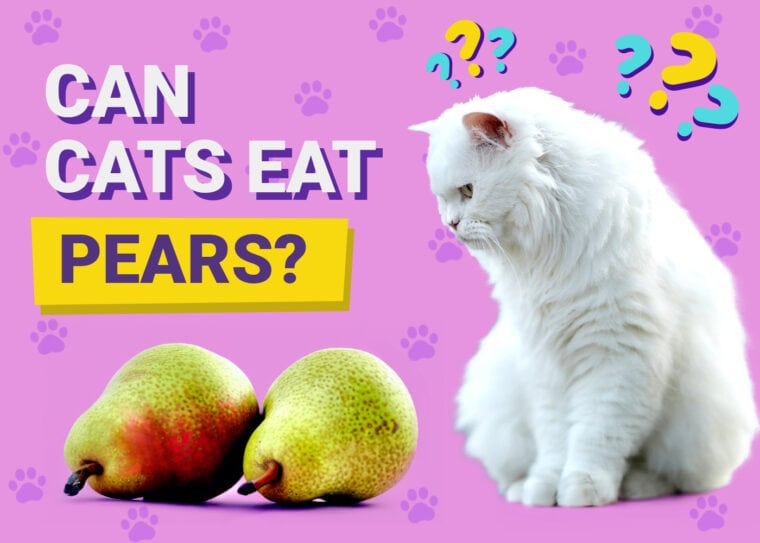
Click to Skip Ahead
If you’re like many cat owners, you love sharing your favorite foods with your cats as long as they’re healthy and nutritious. But what about one of the most cultivated fruits on the planet? Can your cat eat pears safely? You’ll be glad to know that, with a couple of caveats, your cat can safely eat pears, and they provide a wide range of nutrients for your feline. Read on to discover the do’s and don’ts of feeding nutritious, delicious pears to your cat!
Are Pears 100% Safe for Your Cat to Eat?
When clean, ripe, and devoid of seeds, the flesh of the pear fruit is 100% safe for your cat to eat in moderation. What you need to avoid feeding your cat are the seeds of the pear, which like apples and oranges, have a small amount of the poison cyanide in them.
That’s not to say that if your cat ate a single pear seed, they would perish. However, if your curious kitty were to eat several pear seeds, it would certainly upset their stomach and possibly give them diarrhea or make them vomit.
Also, because their digestive system isn’t made to digest fruit sugar (fructose and sucrose), feeding your cat several pear slices could cause diarrhea. Lastly, if your cat is diabetic, you should avoid feeding them fruit of any kind, including pear, as all fruits contain fruit sugar.

Do Cats Need to Eat Fruit Like Pears to Stay Healthy?
It’s important to remember that, as carnivores, cats don’t need fruit. Yes, fruits like pears and many others have vitamins and nutrients that can benefit your cat. As we’ll see below, pears have several vitamins and minerals that are good for your cat’s health.
However, in the wild, cats would never eat pears or other fruits since they get all their nutrition from eating small animals like rats, mice, birds, and other critters. As long as you feed them healthy, nutritious cat food, your cat can live a long, healthy life without ever eating a piece of fruit of any kind.
How Much of the Pear Can Your Cat Eat?
One of the best methods of determining how much of any snack to feed your cat is the 90/10 rule. It states that 90% of the food you feed your cat on any given day should be regular, high-quality cat food. That leaves the other 10% open for pears, fruits, vegetables, and other cat snacks.
So, for example, if your cat eats 10 ounces of cat food, you can give them 1 ounce of snack food, including pear or any other healthy, safe cat snack. One ounce of pear is equal to about two slices.
Should you give two slices of pear to your cat every day? Veterinarians say no and recommend giving this fruit or other fruits and veggies to your cat at most once or twice a week. Again, it’s important to remember that cats don’t need to eat fruit, including pears, to stay healthy. And most cats won’t be the least bit interested in eating pears, anyways.

What are the Nutritional Benefits of Pears for Cats?
Like most fruits, pears are packed with various vitamins, minerals, and other nutrients. Pears are very low in fat but have a lot of sugar, so they must be given to your cat in moderation. Pears also have a moderate level of fiber, which is beneficial for your cat’s digestion. Below is a partial list of the most beneficial nutrients in pears.
What’s interesting to note is that because they can synthesize Vitamin C in their liver, cats don’t need to eat fruit like pears to get the essential antioxidant.
How To Feed Pears to Cats
Feeding pears to your cat as an occasional snack is relatively easy. There’s a small amount of preparation needed but no cooking involved. Here are the basic steps to prepare and feed pears to your feline friends:

Can Your Cat Eat Dried Pear or Canned Pear?
Veterinarians recommend staying away from dried pear and canned pear because both have higher concentrations of sugar which can be unhealthy for your cat. Canned pears, for example, are almost always packaged in syrup loaded with sugar.
Because of the drying process, dried fruits also have high concentrations of sucrose and fructose. They can cause an upset stomach, and in time, they can lead to obesity and dental decay.
Do Cats Taste the Sugar Found in Pears and Other Fruit?
One fascinating fact about cats is that, unlike humans, they can’t taste sweet things. Cats don’t have sweet taste receptors on their tongues, so fruit and other sweet foods don’t attract them. If your cat likes pears, it’s probably due to the moisture or texture of the fruit, but it’s not because of the sweet taste.
Knowing exactly what your feline companion can and cannot eat will help you become the best pet parent. Recognizing that not all cat bowls are equal is also key! The Hepper NomNom Cat Bowl sets itself apart from traditional options by catering to the specific needs of cats. The innovative design offers whisker relief via shallow dishes and promotes digestion with a slight bowl elevation. Find out if the Hepper NomNom is right for your cat by clicking here.
At Pet Keen, we’ve admired Hepper for many years and decided to take a controlling ownership interest so that we could benefit from the outstanding designs of this cool cat company!
Final Thoughts
Cats can eat pears in moderation, and the fruit provides a variety of nutrients, including vitamins, minerals, antioxidants, and fiber. It’s worth mentioning one last time that carnivores don’t need fruit in their diet, but as a snack fed to them in moderation, some cats will enjoy pears. However, most cats prefer cat food or treats primarily made of beef, turkey, or chicken.
Featured Image Credit: 27707, Pixabay








